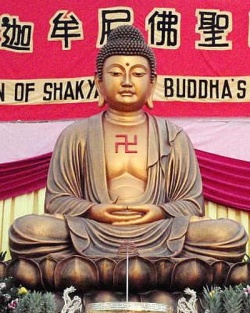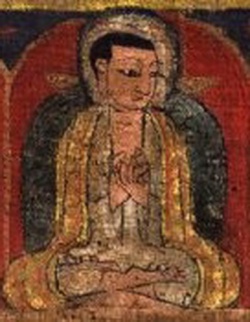Moggaliputta Tissa Thera
Moggaliputta Tissa Thera
President of the Third Council. In his penultimate birth he was a Brahmā, called Tissa, and consented to be born in the world of men at the urgent request of the arahants who held the Second Council, in order to prevent the downfall of the Buddha's religion. He was born in the home of the brahmin Moggali of Pātaliputta. Siggava and Candavajji had been entrusted with the task of converting him. From the time of Tissa's birth, therefore, for seven years, Siggava went daily to the house of Moggali, but not even one word of welcome did he receive. In the eighth year someone said to him, "Go further on." As he went out he met Moggali, and, on being asked whether he had received anything at his house, he said he had. Moggali inquired at home and the next day charged Siggava with lying. But hearing Siggava's explanation, he was greatly pleased and thereafter constantly offered Siggava hospitality at his house. One day, young Tissa, who was thoroughly proficient in the Vedas, was much annoyed at finding Siggava occupying his seat and spoke to him harshly. But Siggava started to talk to him and asked him a question from the Cittayamaka. Tissa could not answer it, and, in order to learn the Buddha's teachings, he entered the Order under Siggava, becoming a sotāpanna soon after. Siggava instructed him in the Vinaya and Candavajji in the Sutta and Abhidhamma Pitaka's. In due course he attained arahantship and became the acknowledged leader of the monks at Pātaliputta (Mhv.v.95ff., 131ff.; Dpv.v.55ff.; Sp.i.35 41).
At the festival of dedication of the Asokārāma and the other vihāras built by Asoka, Moggaliputta Tissa informed Asoka, in answer to a question, that one becomes a kinsman of the Buddha's religion only by letting one's son or daughter enter the Order. Acting on this suggestion, Asoka had both his children ordained. Moggaliputta acted as Mahinda's upajjhāya (Mhv.v.191ff.; Sp.i.50f). Later, because of the great gains which accrued to the monks through Asoka's patronage of the Buddha's religion, the Order became corrupt, and Moggaliputta committed the monks to the charge of Mahinda, and, for seven years, lived in solitary retreat on the Ahogangā pabbata. From there Asoka sent for him to solve his doubts as to what measure of sin belonged to him owing to the murder of the monks by his minister. But Moggaliputta would not come until persuaded that his services were needed to befriend the religion. He traveled by boat to Pātaliputta, and was met at the landing place by the king who helped him out by supporting him on his arm.
According to Sp.i.58, the king had a dream on the preceding night which the soothsayers interpreted to mean that a great ascetic (samananāga) would touch his right hand. As the Thera touched the king's hand the attendants were about to kill him, for to do this was a crime punishable by death. The king, however, restrained them. The Thera took the king's hand as a sign that he accepted him as pupil.
The king, having led him to Rativaddhana Park, begged him to perform a miracle. This the Thera consented to do and made the earth quake in a single region. To convince the king that the murder of the monks involved no guilt for himself, the Thera preached to him the Tittira Jātaka. Within a week, with the aid of two yakkhas, the king had all the monks gathered together and held an assembly at the Asokārāma. In the presence of Moggaliputta, Asoka questioned the monks on their various doctrines, and all those holding heretical views were expelled from the Order, Moggaliputta decreeing that the Vibhajjavāda alone contained the teaching of the Buddha. Later, in association with one thousand arahants, Moggaliputta held the Third Council at Asokārāma, with himself as President, and compiled the Kathāvatthuppakarana, in refutation of false views. This was in the seventeenth year of Asoka's reign and Moggaliputta was seventy two years old (Mhv.v.231 81; Dpv.vii.16ff., 39ff.; Sp.i.57ff). At the conclusion of the Council in nine months, Moggaliputta made arrangements, in the month of Kattika, for monks to go to the countries adjacent to India for the propagation of the religion (For a list of these, see Mhv.xii.1ff.; Dpv.viii.1ff.; Sp.i.63ff). Later, when the request came from Ceylon for a branch of the Bodhi tree, Asoka consulted the Elder as to how this could be carried out, and Moggaliputta told him of the five resolves made by the Buddha on his death bed (Mhv.xviii.21ff).
The Dīpavamsa says (Dpv. 68ff., 82, 94, 96, 100f. 107f.; also vii.23ff ) that Moggaliputta Tissa's ordination was in the second year of Candagutta's reign, when Siggava was sixty four years old. Candagutta reigned for twenty four years, and was followed by Bindusāra, who reigned for thirty seven years, and he was succeeded by Asoka. In the sixth year of Asoka's reign, Moggaliputta was sixty-six years old, and it was then that he ordained Mahinda. He was eighty years old at the time of his death and had been leader of the Order for sixty eight years. He died in the twenty sixth year of Asoka's reign.

